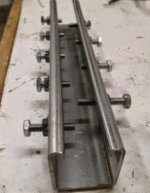FrighteningRod
Member
I have a couple of slasher blades which got a bit bent and twisted thanks to hitting a eucalypt branch hiding in longish grass.
If they were mild steel I could unbend and untwist them without a problem but they are made from a VERY hard steel and I've got nowhere bashing them with a decent sized sledge hammer.
The steel is 4 mm thick and 8 cm wide.
I don't have oxy or propane (or a blacksmith's forge) and I'm out the bush with an hour's drive each way to an engineering shop. Would like to get this job done ASAP, the shop always has a week or so delay for such jobs.
I'm wondering if I could mount a blade in my trusty Dawn 125 vice and run a 2.5mm rod along the bend/twist and get the steel hot enough to work back into shape? And, although they will only be used for easy slashing once sorta straightened - no more long grass with hidden branches to slash - should I worry about annealing or quenching or just let them cool after straightening??
If they were mild steel I could unbend and untwist them without a problem but they are made from a VERY hard steel and I've got nowhere bashing them with a decent sized sledge hammer.
The steel is 4 mm thick and 8 cm wide.
I don't have oxy or propane (or a blacksmith's forge) and I'm out the bush with an hour's drive each way to an engineering shop. Would like to get this job done ASAP, the shop always has a week or so delay for such jobs.
I'm wondering if I could mount a blade in my trusty Dawn 125 vice and run a 2.5mm rod along the bend/twist and get the steel hot enough to work back into shape? And, although they will only be used for easy slashing once sorta straightened - no more long grass with hidden branches to slash - should I worry about annealing or quenching or just let them cool after straightening??


